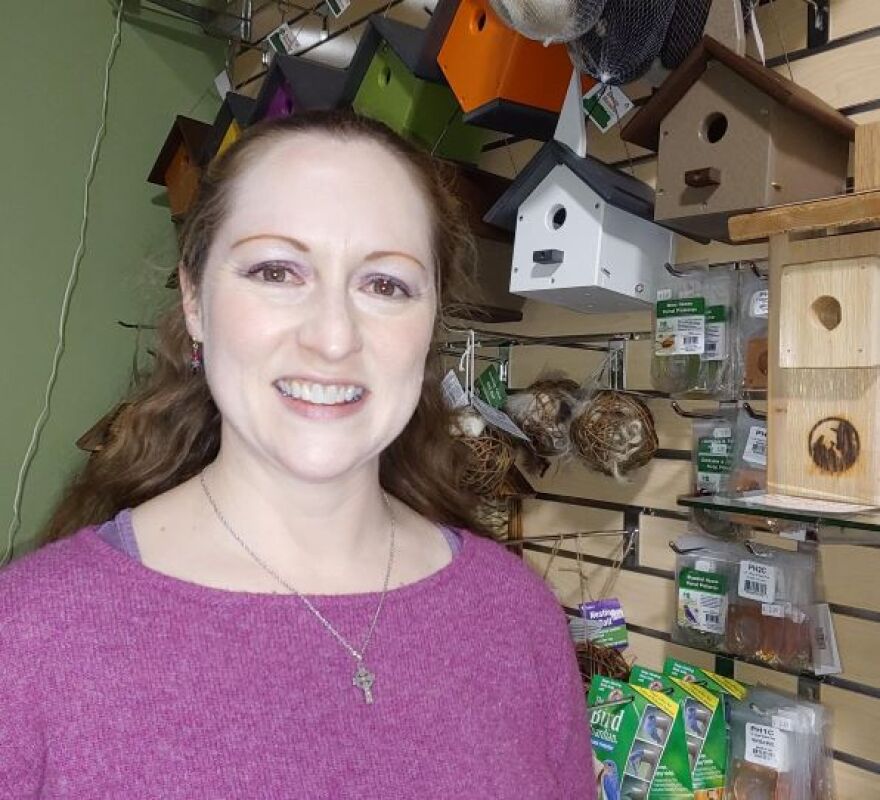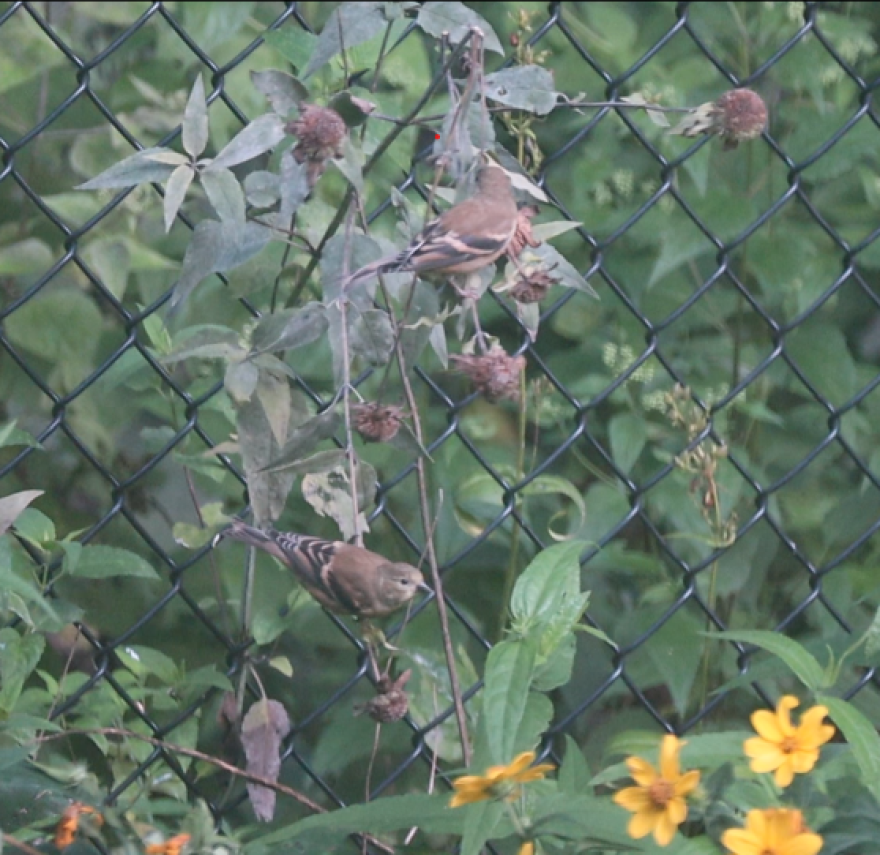JW: Have you ever spent some time watching a bird swooping in on a tree or a flower--performing some impressive acrobatics while looking for a snack? The entire spectacle is just mesmerizing. Have you ever thought about attracting those birds to your own yard? I'm here at Nature Niche in Midland with owner Martha Holzheuer. She says you can bring our feathered friends to your yard with native plants. Thanks for having me here today, Martha.

MH: Thanks so much for coming. Yeah, a lot of people think you have to feed wild birds bird seed, but actually a better way is to plant native plants in your yard.
JW: First of all, define “native plant.”
MH: Sure. So a native plant is a plant that has evolved in a given site or ecosystem with the animals in that ecosystem.
JW: And why do we want to attract birds to our yard?

MH: You can answer that a lot of different ways. I would say, because your yard was the bird's home first. I think because bird watching is fun and good for the soul. And I would say birds really need our help. There are studies out there that show we've lost one in four birds since the 1970s, and by providing them habitat, we can help them.
JW: And the birds are working for us too, aren't they?
MH: Absolutely. They help with pest control naturally, so you don't have to use pesticides. They will help eat different kinds of insects in your yard.
JW: What kinds of birds will we be attracting here in central and northern Michigan?
MH: All sorts of things, like our woodpeckers, our thrushes, finches the cardinals, grossbeaks-- lots of fun things to be seen in your backyard.
JW: And what kind of things attract them-- like the color of a flower or the shape of a flower or the scent?
MH: Certainly the color, the shape of flowers-- hummingbirds like tubular flowers and are attracted to the color red, but also other colors. So they cue on those things as well as food availability and structure like trees, shrubs, grasses. The habitat that you're providing.
JW: Martha, how do we get started?
MH: I would recommend folks to think about what's in their yard and try to provide native plants that provide seeds, fleshy fruit or berries, nectar and plants that we know are really good at providing a lot of insects.
JW: Would you name a few of those plants?

MH: Sure. For doing seeds--our native sunflowers are great. Coreopsis coneflowers, blazing star. The milkweeds, asters and goldenrods. And of course our often overlooked native grasses. For the fleshy fruit, berries. We have wild strawberry bean, baneberry and Jack- in- the-pulpit. Think about our shrubs that do berries--so blueberries, raspberries, blackberries, cherries are all great. And don't forget vines like our wild grapes and Virginia creeper. And then for nectar, our lobelias, great blue lobelia and cardinal flower, a lot of gardeners are familiar with them. Our beard tongues and the genus Penstemon. Our monardas, bee-balm and horsemint. And then columbine, wild columbine, wild lupine, our vervain--great examples, high bush cranberry, and then trumpet creepers are native south of us. So if you take that broader view of what’s native, that's another good one.
JW: Well, there are certainly lots and lots of plants that we could put into our yards and gardens that would help attract birds. And what will we see as the benefit?
MH: I mean, I think having the birds around is a lot of fun, and brings a lot of enjoyment to people. By having native plants, you're attracting and supporting our native insects, which feed lots of things in the food chain, not just our wild birds. And they set up relationships with one another. So one particular species doesn't become overwhelming or a pest, so you have natural pest control going on as well.
JW: Martha, when we plant these native plants into our yard and garden. Do we also need to feed the birds in any other way too, or do anything else for the birds?
MH: For our own enjoyment, a little supplemental feeding is totally fine. I own a nature store. We sell birdseed and suet and things like that. Just make sure you're doing it responsibly, keeping your feeders clean. Thinking like a bird. Trying to help protect them from predators and things like that as you feed.
JW: And just have fun watching all of those birds!
MH: Absolutely. It's amazing. And just a wonderful hobby!
JW: Martha Holzheuer from Nature Niche in Midland. Thanks for having me.
MH: I'm so happy to help! If anybody has questions, come see us. I'm happy to talk more native plants.
JW: Martha Holzheuer and I continued our conversation about why it's important to bring birds into our yard and gardens with native plants.
MH: So yeah, our birds are in a tough spot and a lot of that has to do with changes across our landscape, habitat fragmentation, habitat loss as we put in developments. And so by using our yards as spaces to provide those native plants from the ground cover, the understory, the shrub layer, and the canopy--the tree layer--we help put that habitat back into place and can help restore that even in our own yards. And if we all work together, all our yards connect, and that ties into Dr. Doug Tallamy's idea of a Homegrown National Park-- that our national parks can't support all our wildlife, including our birds. But if we all work together in our own personal, residential and even business landscapes with native plants, we can help provide good habitat that they need.
JW: Many hands make for light work! We can all do our little part.
MH: Yes. Wildlife Habitat Council likes to say every act of conservation matters, and I think that's true. And when I do my environmental education posts, I try to think about what can we do, and even just the little things. If we're all doing a bunch of little things, it all snowballs into a much bigger effort.
JW: We put native plants into our yard and we're just waiting for the birds to come. What are we waiting for? What do we expect to see?
MH: So as your native plants mature, they'll start blooming really well and producing a lot of fruit. So through the winter months you'll see finches and woodpeckers and chickadees and nuthatches and cardinals--species like that. And then as we get into the migratory period, more warblers coming through, a lot of our raptors. Some are year-round, but we also can see them migrating through. And the hummingbirds come back, the orioles come back to us—grossbeaks-- and so we get an even greater mix of birds in our backyard enjoying those plants.
JW: Our backyards could become a very busy place!

MH: Absolutely. Yeah. The best way to attract wildlife is to throw them a party. So you want to think about having food and drink-- water available and space to be able to move around and do the feeding and breeding. Activities that they need to do.
JW: Well, it sounds like fun--along with--it's just a good thing to do.
MH: Yes, absolutely. It's very critical. There's a study that was published in 2019 about basically, we've lost nearly 3 billion--that's billion with a B-- of our breeding birds since the 1970s, or one in four birds. And so, providing habitat for those species is really critical. There are other reasons for that decline. Use of pesticides, invasive species, disease. But one thing within our control is what plants we put in our landscapes and putting in things that provide nesting, habitat and materials places for them to take shelter and nest, and plants that provide really good food, whether that is through the seeds, the fleshy fruit, the nectar, but also some plants are better at providing insect food. And so a great place to go to find for your particular ZIP code, what plants are the best at providing caterpillars, especially. So this website--it's the Native Plant Finder. Doctor Doug Tallamy developed that with the US Forest Service and the National Wildlife Federation. You can plug in your zip code and it'll pop up native plants--the top ones that that host the most butterfly species and moth species. And because 96% of our North American land bird species feed their young insects, we're really helping them do their breeding, reestablish populations, provide really critical habitat for them. So I plugged in my Midland ZIP code, just as an example, and the best trees and shrubs, the top three: oaks, willows and cherries, plums. So if you have limited space, plant an oak, plant a willow or plant a cherry. And on the herbaceous side of things, the wildflowers and grasses, the top three are goldenrods, wild strawberry and sunflowers. So those species in the genus Helianthus. So providing those even in a limited space, if you can be strategic about what native plants you choose to have them offer the most insects for our native wild birds.
JW: Wow, that's a lot of information. Really great information too, Martha. Thanks for all you do here at Nature Niche!
JW: Thank you so much for coming. I learn and research and love to share!
https://nature-niche.com/blogs/news/may-2024-native-plant-sale-spring-into-stewardship
https://nativeplantfinder.nwf.org/
https://homegrownnationalpark.org/



